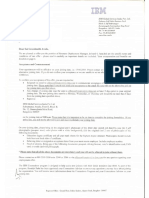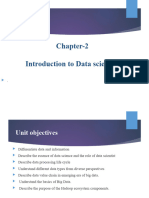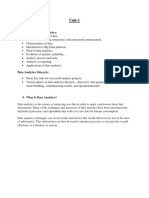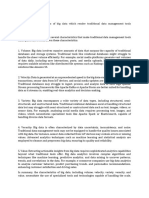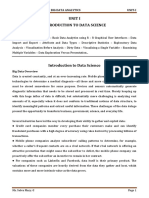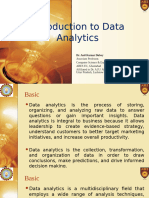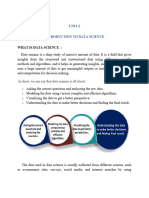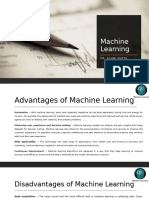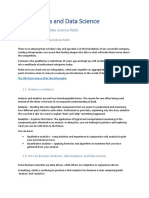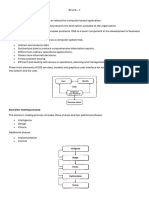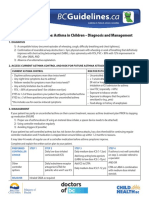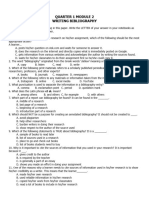Da Unit-1
Da Unit-1
Uploaded by
jaganbecsCopyright:
Available Formats
Da Unit-1
Da Unit-1
Uploaded by
jaganbecsOriginal Title
Copyright
Available Formats
Share this document
Did you find this document useful?
Is this content inappropriate?
Copyright:
Available Formats
Da Unit-1
Da Unit-1
Uploaded by
jaganbecsCopyright:
Available Formats
Data Analytics
CS513PE: DATA ANALYTICS (Professional Elective - I)
BASIC TERMINOLOGIES
BIG DATA
Big data is a field that treats ways to analyze, systematically extract information from, or
otherwise deal with data sets that are too large or complex to be dealt with by traditional
data-processing application software.
4V PROPERTIES OF BIG DATA
Volume
Variety
Velocity
Veracity
Volume of Big Data
The volume of data refers to the size of the data sets that need to be analyzed and processed,
which are now frequently larger than terabytes and petabytes. The sheer volume of the data
requires distinct and different processing technologies than traditional storage and processing
capabilities. In other words, this means that the data sets in Big Data are too large to process
with a regular laptop or desktop processor. An example of a high-volume data set would be
all credit card transactions on a day within Europe.
Velocity of Big Data
Velocity refers to the speed with which data is generated. High velocity data is generated
with such a pace that it requires distinct (distributed) processing techniques. An example of a
data that is generated with high velocity would be Twitter messages or Facebook posts.
Variety of Big Data
Variety makes Big Data really big. Big Data comes from a great variety of sources and
generally is one out of three types: structured, semi structured and unstructured data. The
variety in data types frequently requires distinct processing capabilities and specialist
algorithms. An example of high variety data sets would be the CCTV audio and video files
that are generated at various locations in a city.
Veracity of Big Data
Veracity refers to the quality of the data that is being analyzed. High veracity data has many
records that are valuable to analyze and that contribute in a meaningful way to the overall
results. Low veracity data, on the other hand, contains a high percentage of meaningless data.
Malla Reddy Institute of Technology and Science
Data Analytics
The non-valuable in these data sets is referred to as noise. An example of a high veracity data
set would be data from a medical experiment or trial.
Data that is high volume, high velocity and high variety must be processed with advanced
tools (analytics and algorithms) to reveal meaningful information. Because of these
characteristics of the data, the knowledge domain that deals with the storage, processing, and
analysis of these data sets has been labeled Big Data.
FORMS OF DATA
• Collection of information stored in a particular file is represented as forms of data.
– STRUCTURED FORM
• Any form of relational database structure where relation between attributes
is possible. That there exists a relation between rows and columns in the
database with a table structure. Eg: using database programming languages
(sql, oracle, mysql etc).
– UNSTRUCTURED FORM.
• Any form of data that does not have predefined structure is represented as
unstructured form of data. Eg: video, images, comments, posts, few
websites such as blogs and wikipedia
– SEMI STRUCTURED DATA
• Does not have form tabular data similar to rdbms.
• Predefined organized formats available.
• Eg: csv, xml, json, txt file with tab separator etc..
SOURCES OF DATA
– There are two types of sources of data available.
– PRIMARY SOURCE OF DATA
• Eg: data created by individual or a business concern on their own.
– SECONDARY SOURCE OF DATA
• Eg: data can be extracted from cloud servers, website sources (kaggle, uci,
aws, google cloud, twitter, facebook, youtube, github etc..)
Malla Reddy Institute of Technology and Science
Data Analytics
DATA ANALYSIS
Data analysis is a process of inspecting, cleansing, transforming and modeling data with
the goal of discovering useful information, informing conclusions and supporting decision-
making.
DATA ANALYTICS
• Data analytics is the science of analyzing raw data in order to make conclusions about
that information......This information can then be used to optimize processes to increase
the overall efficiency of a business or system.
Types:
– Descriptive analytics Eg: (observation, case-study, surveys)
In descriptive statistics the result is always going lead with probability among ‘n’
number of options where each option has an equal chance of probability.
– Predictive analytics Eg: healthcare, sports, weather, insurance, social media analysis.
This type of analytics deals with predicting past data to make decisions based on
certain algorithms. In case of a doctor the doctor questions the patient about the
past to correct his illness through already existing procedures.
– Prescriptive analytics Eg: healthcare, banking.
Prescriptive analytics works with predictive analytics, which uses data to determine
near-term outcomes. Prescriptive analytics makes use of machine learning to help
businesses decide a course of action based on a computer program's predictions.
Fig 0.1Relation between Social Media, Data Analysis and Big Data
Malla Reddy Institute of Technology and Science
Data Analytics
Social media data are used in number of domains such as health and political trending
and forecasting, hobbies, ebusiness,cyber-crime, counter terrorism, time-evolving opinion
mining, social net-work analysis, and human machineinteractions.
Finally, summarizing all the above concepts processing for social media data can be
categorized into 3 parts as shown infigure 0.1. The first part consists of social media
websites, the second part consists of data analysis part and the thirdpart consists of big data
management layer and schedules the jobs across the cluster.
DIFFERENCE BETWEEN DATA ANALYTICS AND DATA ANALYSIS
Characteristics Data Analytics Data Analysis
Form Used in business to make Form of data analytics in business
decision from data – Data Driven to identify useful information in
data.
Structure It is a process of data collection Cleaning, transforming the data
with various strategies
Tools Excel, python, R etc.. KNIME, NodeXL, Rapid Miner etc..
Prediction Analytics means we are trying Analysis means we analyze always
to find conclusions about future. what has happened in the past
MACHINE LEARNING
• Machine learning is an application of artificial intelligence (AI) that provides systems
the ability to automatically learn and improve from experience without being
explicitly programmed.
• Machine learning focuses on the development of computer programs that can access
data and use it learn for themselves.
Analytics
Fig 0.2Relation betweenmachine learning and data analytics
Malla Reddy Institute of Technology and Science
Data Analytics
In general data is passed to a machine learning tool to perform descriptive data analytics
through set of algorithms built in it. Here both data analytics and data analysis is done by the
tool automatically. Hence we can say that Data analysis is a sub component of data analytics.
And data analytics is a sub component of machine learning tool. All these are described in
figure 0.2. The output of this machine learning tool generates a model. And from this model
predictive analytics and prescriptive analytics can be performed because the model gives
output as data to machine learning tool. This cycle continues till we get an efficient output.
Malla Reddy Institute of Technology and Science
Data Analytics
UNIT - I
1.1 DESIGN DATA ARCHITECTURE AND MANAGE THE DATA FOR ANALYSIS
Data architecture is composed of models, policies, rules or standards that govern which
data is collected, and how it is stored, arranged, integrated, and put to use in data systems
and in organizations. Data is usually one of several architecture domains that form the
pillars of an enterprise architecture or solution architecture.
Various constraints and influences will have an effect on data architecture design. These
include enterprise requirements, technology drivers, economics, business policies and data
processing needs.
• Enterpriserequirements
These will generally include such elements as economical and effective system
expansion, acceptable performance levels (especially system access speed), transaction
reliability, and transparent data management. In addition, the conversion of raw data such as
transaction records and image files into more useful information forms through such
features as data warehouses is also a common organizational requirement, since this enables
managerial decision making and other organizational processes. One of the architecture
techniques is the split between managing transaction data and (master) reference data.
Another one is splitting data capture systems from data retrieval systems (as done in a
datawarehouse).
• Technologydrivers
These are usually suggested by the completed data architecture and database
architecture designs. In addition, some technology drivers will derive from existing
organizational integration frameworks and standards, organizational economics, and
existing site resources (e.g. previously purchased software licensing).
• Economics
These are also important factors that must be considered during the data architecture phase.
It is possible that some solutions, while optimal in principle, may not be potential
candidates due to their cost. External factors such as the business cycle, interest rates,
market conditions, and legal considerations could all have an effect on decisions relevant to
data architecture.
Businesspolicies
Business policies that also drive data architecture design include internal organizational
policies, rules of regulatory bodies, professional standards, and applicable governmental
laws that can vary by applicable agency. These policies and rules will help describe the
manner in which enterprise wishes to process their data.
Malla Reddy Institute of Technology and Science
Data Analytics
• Data processingneeds
These include accurate and reproducible transactions performed in high volumes, data
warehousing for the support of management information systems (and potential data
mining), repetitive periodic reporting, ad hoc reporting, and support of various
organizational initiatives as required (i.e. annual budgets, new productdevelopment).
The General Approach is based on designing the Architecture at three Levels of
Specification as shown below in figure 1.1
The LogicalLevel
The PhysicalLevel
The ImplementationLevel
Fig 1.1: Three levels architecture in data analytics.
The logical view/user's view, of a data analytics represents data in a format that is
meaningful to a user and to the programs that process those data. That is, the logical
view tells the user, in user terms, what is in the database. Logical level consists of data
requirements and process models which are processed using any data modelling techniques to
result in logical data model.
Physical level is created when we translate the top level design in physical tables in
the database. This model is created by the database architect, software architects, software
developers or database administrator. The input to this level from logical level and various
data modeling techniques are used here with input from software developers or database
administrator. These data modelling techniques are various formats of representation of data
Malla Reddy Institute of Technology and Science
Data Analytics
such as relational data model, network model, hierarchical model, object oriented model,
Entity relationship model.
Implementation level contains details about modification and presentation of data through
the use of various data mining tools such as (R-studio, WEKA, Orange etc). Here each tool
has a specific feature how it works and different representation of viewing the same data.
These tools are very helpful to the user since it is user friendly and it does not require much
programming knowledge from the user.
1.2 Various Sources of Data
Understand various primary sources of the Data
Data can be generated from two types of sources namely Primary and Secondary
Sources of Primary Data
The sources of generating primary data are -
ObservationMethod
SurveyMethod
ExperimentalMethod
Observation Method:
Fig 1.2: Data collections
An observation is a data collection method, by which you gather knowledge of the
researched phenomenon through making observations of the phenomena, as and when it
occurs. The main aim is to focus on observations of human behavior, the use of the
phenomenon and human interactions related to the phenomenon. We can also make
observations on verbal and nonverbal expressions. In making and documenting observations,
Malla Reddy Institute of Technology and Science
Data Analytics
we need to clearly differentiate our own observations from the observations provided to us by
other people. The range of data storage genre found in Archives and Collections, is suitable
for documenting observations e.g. audio, visual, textual and digital including sub-genres
of note taking, audio recording and video recording.
There exist various observation practices, and our role as an observer may vary
according to the research approach. We make observations from either the outsider or insider
point of view in relation to the researched phenomenon and the observation technique can be
structured or unstructured. The degree of the outsider or insider points of view can be seen as
a movable point in a continuum between the extremes of outsider and insider. If you decide
to take the insider point of view, you will be a participant observer in situ and actively
participate in the observed situation or community. The activity of a Participant observer in
situ is called field work. This observation technique has traditionally belonged to the data
collection methods of ethnology and anthropology. If you decide to take the outsider point of
view, you try to try to distance yourself from your own cultural ties and observe the
researched community as an outsider observer. These details are seen in figure 1.2.
Experimental Designs
There are number of experimental designs that are used in carrying out and
experiment. However, Market researchers have used 4 experimental designs most frequently.
These are –
CRD - Completely Randomized Design
A completely randomized design (CRD) is one where the treatments are assigned
completely at random so that each experimental unit has the same chance of receiving any
one treatment. For the CRD, any difference among experimental units receiving the same
treatment is considered as experimental error. Hence, CRD is appropriate only for
experiments with homogeneous experimental units, such as laboratory experiments, where
environmental effects are relatively easy to control. For field experiments, where there is
generally large variation among experimental plots in such environmental factors as soil, the
CRD is rarely used. CRD is mainly used in agricultural field.
Step 1. Determine the total number of experimental plots (n) as the product of the number of
treatments (t) and the number of replications (r); that is, n = rt. For our example, n = 5 x 4 =
20. Here, one pot with a single plant in it may be called a plot. In case the number of
replications is not the same for all the treatments, the total number of experimental pots is to
be obtained as the sum of the replications for each treatment. i.e.,
n= i
where ri, is the number of times the ith treatment replicated
Malla Reddy Institute of Technology and Science
Data Analytics
Step 2. Assign a plot number to each experimental plot in any convenient manner; for
example, consecutively from 1 to n.
Step 3. Assign the treatments to the experimental plots randomly using a table of random
numbers.
Example 1: Assume that a farmer wishes to perform the experiment to determine which of
his 3 fertilizers to use on 2800 tress. Assuming that farmer has a farm divided in to 3 terraces,
where those 2800 trees can be divided in the below format
Lower Terrace 1200
Middle Terrace 1000
Upper Terrace 600
Design a CRD for this experiment
Solution
Scenario 1
First we divide the 2800 trees in to random assignment of almost 3 equal parts
Random Assignment1: 933 trees
Random Assignment2: 933 trees
Random Assignment3: 934 trees
So for example random assignment1 we can assign fertilizer1, random assignment2 we can
assign fertilizer2, random assignment3 we can assign fertilizer3.
Scenario 2
2800 trees is divided into terrace as shown below
Total no of Terrace Random Fertilizer
trees assignment usage
Upper 200 fertilizer1
Terrace 200 fertilizer2
(600 trees) 200 fertilizer3
Middle 400 fertilizer1
2800 Trees Terrace 400 fertilizer2
(1200 trees) 400 fertilizer3
Lower 333 fertilizer1
Terrace 333 fertilizer2
(1000 trees) 334 fertilizer3
Thus the farmer will be able analyze and compare various fertilizer performance on different
terrace.
Malla Reddy Institute of Technology and Science
Data Analytics
Example 2:
A company wishes to test 4 different types of tyre. The tyres lifetime as determined
from their threads are given. Where each tyre has been tried on 6 similar automobiles
assigned at random to their tyres. Determine whether there is a significant difference between
tyres at .05 level.
Tyres Automobile Automobile Automobile Automobile Automobile Automobile
1 2 3 4 5 6
A 33 38 36 40 31 35
B 32 40 42 38 30 34
C 31 37 35 33 34 30
D 29 34 32 30 33 31
Solution:
Null Hypothesis: There is no difference between the tyres in their life time.
We choose a random value closest to the average of all values in the table and subtract that
for each tyre in the automobile, for example by choosing 35
Tyres Automobile Automobile Automobile Automobile Automobile Automobile Total
1 2 3 4 5 6
A -2 3 1 5 -4 0 3
B -3 5 7 3 -5 -1 6
C -4 2 0 -2 -1 -5 -10
D 6 -1 -3 -5 -2 -4 -21
T = Sum(X) = -22
N = no of samples = 24 (4 rows * 6 columns)
Correction factor = = 20.16
Square the values to find
Tyres Automobile Automobile Automobile Automobile Automobile Automobile Total
1 2 3 4 5 6
A 4 9 1 25 16 0 55
B 9 25 9 49 25 1 118
C 16 4 0 4 1 25 50
D 36 1 9 25 4 16 91
T = Sum(X2) = 314
Malla Reddy Institute of Technology and Science
Data Analytics
Total sum of squares (SST) = sum(X2) – Correlation factor
= 314 – 20.16 = 293.84
Sum of Squares between Treatments (SSTr) =
= ((3)2/6 +(6)2/6 +(10)2/6 +(21)2/6) – Correlation factor = 77.50
Sum of Squares Error (SSE) SST – SSTr = 293.84 – 77.50 =
216.34
Now by using ANOVA (one way classification) Table, We calculate the F- Ratio.
F-Ratio:
The F ratio is the ratio of two mean square values. If the null hypothesis is true, you
expect F to have a value close to 1.0 most of the time. A large F ratio means that the variation
among group mean is more than you'd expect to see by chance
If the value of F-Ratio is closer to 1 it means that null hypothesis is true. If F-ratio is
greater than then we assume that the null hypothesis is false.
Source of Sum of Degrees of Mean of sum of F - Ratio
variation squares freedom squares
Between SSTr = 77.50 No of treatment – MSTr = SSTr/
treatments 1 Degrees of
= 4-1 =3 Freedom =
77.50/3 = 25.83
F-ratio =
MSTr/MSE =
25.83/10.87 =
2.376
Within SSE = 216.34 No of values – no MSE =
treatments of treatment = 24 SSE/Degrees of
– 4 =20 Freedom
=216.34/20
=10.87
In this scenario the value of F-ratio is greater than 1. This indicates there will be variation
between samples. So assumed null hypothesis will be false
Level of significance = 0.05 (given in question)
Degrees of Freedom = (3, 20)
Critical value = 3.10 (calculated from 5 percentage table)
F-Ratio >critical value (i.e) 2.376> 3.10
Hence assumed null hypothesis is false. This indicates there is life time difference between
tyres.
Malla Reddy Institute of Technology and Science
Data Analytics
A randomized block design, the experimenter divides subjects into subgroups called
blocks, such that the variability within blocks is less than the variability between blocks.
Then, subjects within each block are randomly assigned to treatment conditions. Compared to
a completely randomized design, this design reduces variability within treatment conditions
and potential confounding, producing a better estimate of treatment effects.
The table below shows a randomized block design for a hypothetical medical experiment.
Gender Treatment
Placebo Vaccine
Male 250 250
Female 250 250
Subjects are assigned to blocks, based on gender. Then, within each block, subjects are
randomly assigned to treatments (either a placebo or a cold vaccine). For this design, 250
men get the placebo, 250 men get the vaccine, 250 women get the placebo, and 250 women
get the vaccine.
It is known that men and women are physiologically different and react differently to
medication. This design ensures that each treatment condition has an equal proportion of men
and women. As a result, differences between treatment conditions cannot be attributed to
gender. This randomized block design removes gender as a potential source of variability and
as a potential confounding variable.
LSD - Latin Square Design - A Latin square is one of the experimental designs which has a
balanced two-way classification scheme say for example - 4 X 4 arrangement. In this scheme
each letter from A to D occurs only once in each row and also only once in each column. The
balance arrangement, it may be noted that, will not get disturbed if any row gets changed with
the other.
A B C D
B C D A
C D A B
D A B C
The balance arrangement achieved in a Latin Square is its main strength. In this design, the
comparisons among treatments, will be free from both differences between rows and
columns. Thus the magnitude of error will be smaller than any other design.
FD - Factorial Designs - This design allows the experimenter to test two or more variables
simultaneously. It also measures interaction effects of the variables and analyzes the impacts
of each of the variables.
Malla Reddy Institute of Technology and Science
Data Analytics
In a true experiment, randomization is essential so that the experimenter can infer cause and
effect without any bias.
Sources of Secondary Data
While primary data can be collected through questionnaires, depth interview, focus
group interviews, case studies, experimentation and observation; The secondary data can be
obtained through
Internal Sources - These are within theorganization
External Sources - These are outside theorganization
Internal Sources ofData
Internal sources
If available, internal secondary data may be obtained with less time, effort and money
than the external secondary data. In addition, they may also be more pertinent to the situation
at hand since they are from within the organization. The internal sources include
Accounting resources- This gives so much information which can be used by the marketing
researcher. They give information about internal factors.
Sales Force Report- It gives information about the sale of a product. The information
provided is of outside theorganization.
Internal Experts- These are people who are heading the various departments. They can give
an idea of how a particular thing isworking
Miscellaneous Reports- These are what information you are getting from operational
reports.If the data available within the organization are unsuitable or inadequate, the marketer
should extend the search to external secondary data sources.
External Sources of Data
External Sources are sources which are outside the company in a larger environment.
Collection of external data is more difficult because the data have much greater variety and
the sources are much more numerous.
External data can be divided into following classes.
Government Publications- Government sources provide an extremely rich pool of data for
the researchers. In addition, many of these data are available free of cost on internet websites.
There are number of government agencies generating data. These are:
Malla Reddy Institute of Technology and Science
Data Analytics
Registrar General of India- It is an office which generates demographic data. It includes
details of gender, age, occupation etc.
Central Statistical Organization- This organization publishes the national accounts
statistics. It contains estimates of national income for several years, growth rate, and rate of
major economic activities. Annual survey of Industries is also published by the CSO. It gives
information about the total number of workers employed, production units, material used and
value added by themanufacturer.
Director General of Commercial Intelligence- This office operates from Kolkata. It gives
information about foreign trade i.e. import and export. These figures are provided region-
wise and country-wise.
Ministry of Commerce and Industries- This ministry through the office of economic
advisor provides information on wholesale price index. These indices may be related to a
number of sectors like food, fuel, power, food grains etc. It also generates All India
Consumer Price Index numbers for industrial workers, urban, non-manual employees and
cultural labourers.
Planning Commission- It provides the basic statistics of Indian Economy.
Reserve Bank of India- This provides information on Banking Savings and investment. RBI
also prepares currency and finance reports.
Labour Bureau- It provides information on skilled, unskilled, white collared jobs etc.
National Sample Survey- This is done by the Ministry of Planning and it provides social,
economic, demographic, industrial and agricultural statistics.
Department of Economic Affairs- It conducts economic survey and it also generates
information on income, consumption, expenditure, investment, savings and foreign trade.
State Statistical Abstract- This gives information on various types of activities related to the
state like - commercial activities, education, occupation etc.
Non-Government Publications- These includes publications of various industrial and trade
associations, such as
The Indian Cotton Mill Association Various chambers of commerce
The Bombay Stock Exchange (it publishes a directory containing financial accounts, key
profitability and other relevant matter)
Various Associations of Press Media. Export Promotion Council.
Malla Reddy Institute of Technology and Science
Data Analytics
Confederation of Indian Industries (CII)
Small Industries Development Board of India
Different Mills like - Woolen mills, Textile mills etc
The only disadvantage of the above sources is that the data may be biased. They are likely to
colour their negative points.
Syndicate Services- These services are provided by certain organizations which collect and
tabulate the marketing information on a regular basis for a number of clients who are the
subscribers to these services. So the services are designed in such a way that the information
suits the subscriber. These services are useful in television viewing, movement of consumer
goods etc. These syndicate services provide information data from both household as well as
institution.
In collecting data from household they use three approaches Survey- They conduct surveys
regarding - lifestyle, sociographic, general topics. Mail Diary Panel- It may be related to 2
fields - Purchase and Media.
Electronic Scanner Services- These are used to generate data on volume.
They collect data for Institutions from Whole sellers, Retailers, and Industrial Firms
Various syndicate services are Operations Research Group (ORG) and The Indian
Marketing Research Bureau (IMRB).
Importance of Syndicate Services
Syndicate services are becoming popular since the constraints of decision making are
changing and we need more of specific decision-making in the light of changing
environment. Also Syndicate services are able to provide information to the industries at a
low unit cost.
Disadvantages of Syndicate Services
The information provided is not exclusive. A number of research agencies provide
customized services which suits the requirement of each individual organization.
International Organization- These includes
The International Labour Organization (ILO)- It publishes data on the total and active
population, employment, unemployment, wages and consumer prices
The Organization for Economic Co-operation and development (OECD) - It publishes data
on foreign trade, industry, food, transport, and science andtechnology.
The International Monetary Fund (IMA) - It publishes reports on national and
international foreign exchange regulations.
Malla Reddy Institute of Technology and Science
Data Analytics
1.2.1 Comparison of sources of data
Based on various features (cost, data, process, source time etc.) various sources of
data can be compared as per table 1.
Table 1: Difference between primary data and secondary data.
Comparison Feature Primary data Secondary data
Meaning Data that is collected by a Data that is collected by
researcher. other people.
Data Real time data Past data.
Process Very involved Quick and easy
Source Surveys, interviews, or Books, journals, publications
experiments, questionnaire, etc..
interview etc..
Cost effectiveness Expensive Economical
Collection time Long Short
Specific Specific to researcher need May not be specific to
researcher need
Available Crude form Refined form
Accuracy and reliability More Less
1.3 Understanding Sources of Data from Sensor
Sensor data is the output of a device that detects and responds to some type of input
from the physical environment. The output may be used to provide information or input to
another system or to guide a process. Examples are as follows
A photosensor detects the presence of visible light, infrared transmission (IR) and/or
ultraviolet (UV) energy.
Lidar, a laser-based method of detection, range finding and mapping, typically uses a
low-power, eye-safe pulsing laser working in conjunction with a camera.
A charge-coupled device (CCD) stores and displays the data for an image in such a way
that each pixel is converted into an electrical charge, the intensity of which is related to a
color in the color spectrum.
Smart grid sensors can provide real-time data about grid conditions, detecting outages,
faults and load and triggering alarms.
Wireless sensor networks combine specialized transducers with a communications
infrastructure for monitoring and recording conditions at diverse locations. Commonly
monitored parameters include temperature, humidity, pressure, wind direction and speed,
illumination intensity, vibration intensity, sound intensity, powerline voltage, chemical
concentrations, pollutant levels and vital body functions.
Malla Reddy Institute of Technology and Science
Data Analytics
1.4 Understanding Sources of Data from Signal
The simplest form of signal is a direct current (DC) that is switched on and off; this is
the principle by which the early telegraph worked. More complex signals consist of an
alternating-current (AC) or electromagnetic carrier that contains one or more data streams.
Data must be transformed into electromagnetic signals prior to transmission across a
network. Data and signals can be either analog or digital. A signal is periodic if it consists
of a continuously repeating pattern.
1.5 Understanding Sources of Data from GPS
The Global Positioning System (GPS) is a space based navigation system that
provides location and time information in all weather conditions, anywhere on or near the
Earth where there is an unobstructed line of sight to four or more GPS satellites. The system
provides critical capabilities to military, civil, and commercial users around the world. The
United States government created the system, maintains it, and makes it freely accessible to
anyone with a GPS receiver.
1.6 Data Management
Data management is the development and execution of architectures, policies,
practices and procedures in order to manage the information lifecycle needs of an enterprise
in an effective manner.
1.7 Data Quality
Data quality refers to the quality of data. Data quality refers to the state of qualitative
or quantitative pieces of information. There are many definitions of data quality but data is
generally considered high quality if it is "fit for [its] intended uses in operations, decision
making and planning
The seven characteristics that define data quality are:
1. Accuracy and Precision
2. Legitimacy and Validity
3. Reliability and Consistency
4. Timeliness and Relevance
5. Completeness and Comprehensiveness
6. Availability and Accessibility
7. Granularity and Uniqueness
Accuracy and Precision: This characteristic refers to the exactness of the data. It cannot
have any erroneous elements and must convey the correct message without being misleading.
This accuracy and precision have a component that relates to its intended use. Without
understanding how the data will be consumed, ensuring accuracy and precision could be off-
Malla Reddy Institute of Technology and Science
Data Analytics
target or more costly than necessary. For example, accuracy in healthcare might be more
important than in another industry (which is to say, inaccurate data in healthcare could have
more serious consequences) and, therefore, justifiably worth higher levels of investment.
Legitimacy and Validity: Requirements governing data set the boundaries of this
characteristic. For example, on surveys, items such as gender, ethnicity, and nationality
are typically limited to a set of options and open answers are not permitted. Any answers
other than these would not be considered valid or legitimate based on the survey’s
requirement. This is the case for most data and must be carefully considered when
determining its quality. The people in each department in an organization understand what
data is valid or not to them, so the requirements must be leveraged when evaluating data
quality.
Reliability and Consistency: Many systems in today’s environments use and/or collect the
same source data. Regardless of what source collected the data or where it resides, it cannot
contradict a value residing in a different source or collected by a different system. There must
be a stable and steady mechanism that collects and stores the data without contradiction or
unwarranted variance.
Timeliness and Relevance: There must be a valid reason to collect the data to justify the
effort required, which also means it has to be collected at the right moment in time. Data
collected too soon or too late could misrepresent a situation and drive inaccurate
decisions.
Completeness and Comprehensiveness: Incomplete data is as dangerous as inaccurate
data. Gaps in data collection lead to a partial view of the overall picture to be displayed.
Without a complete picture of how operations are running, uninformed actions will occur. It’s
important to understand the complete set of requirements that constitute a comprehensive set
of data to determine whether or not the requirements are being fulfilled.
Availability and Accessibility: This characteristic can be tricky at times due to legal and
regulatory constraints. Regardless of the challenge, though, individuals need the right level of
access to the data in order to perform their jobs. This presumes that the data exists and is
available for access to be granted.
Granularity and Uniqueness: The level of detail at which data is collected is important,
because confusion and inaccurate decisions can otherwise occur. Aggregated, summarized
and manipulated collections of data could offer a different meaning than the data
implied at a lower level. An appropriate level of granularity must be defined to provide
sufficient uniqueness and distinctive properties to become visible. This is a requirement for
operations to function effectively.
Malla Reddy Institute of Technology and Science
Data Analytics
Noisy data is meaningless data. The term has often been used as a synonym for
corrupt data. However, its meaning has expanded to include any data that cannot be
understood and interpreted correctly by machines, such as unstructured text.
An outlier is an observation that lies an abnormal distance from other values in a
random sample from a population. In a sense, this definition leaves it up to the analyst (or a
consensus process) to decide what will be considered abnormal.
In statistics, missing data, or missing values, occur when no data value is stored for
the variable in an observation. Missing data are a common occurrence and can have a
significant effect on the conclusions that can be drawn from the data. Missing values can be
replaced by following techniques:
Ignore the record with missing values.
Replace the missing term with constant.
Fill the missing value manually based on domain knowledge.
Replace them with mean (if data is numeric) or frequent value (if data is
categorical)
Use of modelling techniques such decision trees, baye`s algorithm, nearest
neighbor algorithm Etc.
In computing, data deduplication is a specialized data compression technique for
eliminating duplicate copies of repeating data. Related and somewhat synonymous terms are
intelligent (data) compression and single instance (data) storage.
Noisy data
For objects, noise is considered an extraneous object.
For attributes, noise refers to modification of original values.
Examples: distortion of a person’s voice when talking on a poor phone and “snow” on
television screen
We can talk about signal to noise ratio.
Left image of 2 sine waves has low or zero SNR; the right image are the two waves
combined with noise and has high SNR
Origins of noise
outliers -- values seemingly out of the normal range of data
duplicate records -- good database design should minimize this (use DISTINCT on
SQL retrievals)
incorrect attribute values -- again good db design and integrity constraints should
minimize this
numeric only, deal with rogue strings or characters where numbers should be.
null handling for attributes (nulls=missing values)
Malla Reddy Institute of Technology and Science
Data Analytics
Missing Data Handling
Many causes: malfunctioning equipment, changes in experimental design, collation of
different data sources, measurement not possible. People may wish to not supply information.
Information is not applicable (childen don't have annual income)
Discard records with missing values
Ordinal-continuous data, could replace with attribute means
Substitute with a value from a similar instance
Ignore missing values, i.e., just proceed and let the tools deals with them
Treat missing values as equals (all share the same missing value code)
Treat missing values as unequal values
BUT...Missing (null) values may have significance in themselves (e.g. missing test in a
medical examination, deathdate missing means still alive!)
Missing completely at random (MCAR)
Missingness of a value is independent of attributes
Fill in values based on the attribute as suggested above (e.g. attribute mean)
Analysis may be unbiased overall
Missing at Random (MAR)
Missingness is related to other variables
Fill in values based other values (e.g., from similar instances)
Almost always produces a bias in the analysis
Missing Not at Random (MNAR)
Missingness is related to unobserved measurements
Informative or non-ignorable missingness
Duplicate Data
Data set may include data objects that are duplicates, or almost duplicates of one another
A major issue when merging data from multiple, heterogeneous sources
Examples: Same person with multiple email addresses
1.8 Data Preprocessing
Data preprocessing is a data mining technique that involves transforming
raw data into an understandable format. Real-world data is often incomplete, inconsistent,
and/or lacking in certain behaviors or trends, and is likely to contain many errors. Data
preprocessing is a proven method of resolving such issues.
Data goes through a series of steps during preprocessing:
Malla Reddy Institute of Technology and Science
Data Analytics
Data Cleaning: Data is cleansed through processes such as filling in missing values,
smoothing the noisy data, or resolving the inconsistencies in the data.
Data Integration: Data with different representations are put together and conflicts
within the data are resolved.
Data Transformation: Data is normalized, aggregated and generalized.
Data Reduction: This step aims to present a reduced representation of the data in a
data warehouse.
Data Discretization: Involves the reduction of a number of values of a continuous attribute
by dividing the range of attribute intervals.
Steps Involved in Data Preprocessing:
1. Data Cleaning:
The data can have many irrelevant and missing parts. To handle this part, data cleaning is
done. It involves handling of missing data, noisy data etc.
(a). Missing Data:
This situation arises when some data is missing in the data. It can be handled in
various ways.
Some of them are:
1. Ignore the tuples:
This approach is suitable only when the dataset we have is quite large and
multiple values are missing within a tuple.
2. Fill the Missing values:
There are various ways to do this task. You can choose to fill the missing
values manually, by attribute mean or the most probable value.
(b). Noisy Data:
Noisy data is a meaningless data that can’t be interpreted by machines.It can be
generated due to faulty data collection, data entry errors etc. It can be handled in
following ways :
1. Binning Method:
This method works on sorted data in order to smooth it. The whole data is
divided into segments of equal size and then various methods are performed to
complete the task. Each segmented is handled separately. One can replace all
data in a segment by its mean or boundary values can be used to complete the
task.
2. Regression:
Here data can be made smooth by fitting it to a regression function.The
regression used may be linear (having one independent variable) or multiple
(having multiple independent variables).
3. Clustering:
This approach groups the similar data in a cluster. The outliers may be
undetected or it will fall outside the clusters.
Malla Reddy Institute of Technology and Science
Data Analytics
2. Data Transformation:
This step is taken in order to transform the data in appropriate forms suitable for mining
process. This involves following ways:
1. Normalization:
It is done in order to scale the data values in a specified range (-1.0 to 1.0 or 0.0 to
1.0)
2. Attribute Selection:
In this strategy, new attributes are constructed from the given set of attributes to help
the mining process.
3. Discretization:
This is done to replace the raw values of numeric attribute by interval levels or
conceptual levels.
4. Concept Hierarchy Generation:
Here attributes are converted from level to higher level in hierarchy. For Example-
The attribute “city” can be converted to “country”.
3. Data Reduction:
Since data mining is a technique that is used to handle huge amount of data. While working
with huge volume of data, analysis became harder in such cases. In order to get rid of this, we
uses data reduction technique. It aims to increase the storage efficiency and reduce data
storage and analysis costs.
The various steps to data reduction are:
1. Data Cube Aggregation:
Aggregation operation is applied to data for the construction of the data cube.
2. Attribute Subset Selection:
The highly relevant attributes should be used, rest all can be discarded. For
performing attribute selection, one can use level of significance and p- value of the
attribute.the attribute having p-value greater than significance level can be discarded.
3. Numerosity Reduction:
This enable to store the model of data instead of whole data, for example: Regression
Models.
4. Dimensionality Reduction:
This reduce the size of data by encoding mechanisms.It can be lossy or lossless. If
after reconstruction from compressed data, original data can be retrieved, such
reduction are called lossless reduction else it is called lossy reduction. The two
effective methods of dimensionality reduction are:Wavelet transforms and PCA
(Principal Componenet Analysis).
Malla Reddy Institute of Technology and Science
You might also like
- Seminar On Data ScienceDocument25 pagesSeminar On Data Sciencekebe Aman100% (7)
- Name: Aparna Kavadi Hyderabad, Telangana Shiva Shankar Kammari Sai Greeshmith AvulaDocument3 pagesName: Aparna Kavadi Hyderabad, Telangana Shiva Shankar Kammari Sai Greeshmith Avulajaganbecs67% (3)
- Digital Booklet - Who You AreDocument12 pagesDigital Booklet - Who You AreWalisson Oliveira50% (2)
- The Bonds of Magic - Volume IDocument18 pagesThe Bonds of Magic - Volume Icelticalan8558100% (8)
- 1ielts Speaking Actual Tests and Suggested Answers SeptemberDocument215 pages1ielts Speaking Actual Tests and Suggested Answers Septemberziror11100% (2)
- 1C02-01 Conceptual Design of Buildings PDFDocument14 pages1C02-01 Conceptual Design of Buildings PDFmutashima100% (1)
- Data Analytics III-iDocument85 pagesData Analytics III-iN MAHBOOB SUBANINo ratings yet
- Module 1Document35 pagesModule 1Jha JeeNo ratings yet
- Unit 1Document61 pagesUnit 1Keshav BagaadeNo ratings yet
- AD3491 - FDSA - Unit I - Introduction - Part IDocument23 pagesAD3491 - FDSA - Unit I - Introduction - Part IR.Mohan Kumar100% (1)
- Ccs 334Document16 pagesCcs 334Amsaveni .amsaveniNo ratings yet
- DA Unit 1Document24 pagesDA Unit 1Ajay Kumar ReddyNo ratings yet
- File 1Document3 pagesFile 1rathnaNo ratings yet
- Unit 1Document28 pagesUnit 1mayura.shelkeNo ratings yet
- Introduction To Business and Data Analysis Undergraduate-1Document66 pagesIntroduction To Business and Data Analysis Undergraduate-1Quacoo JusticeNo ratings yet
- Unit1 R Full MaterialDocument11 pagesUnit1 R Full MaterialRamesh VarmaNo ratings yet
- Chapter - 2 - Data ScienceDocument32 pagesChapter - 2 - Data Scienceaschalew woldeyesusNo ratings yet
- TP 4 2docuatrimestreDocument10 pagesTP 4 2docuatrimestreleocorrea779No ratings yet
- Big Data and Data Analysis: Offurum Paschal I Kunoch Education and Training College, OwerriDocument35 pagesBig Data and Data Analysis: Offurum Paschal I Kunoch Education and Training College, OwerriSixtus OkoroNo ratings yet
- big-data-unit 1Document23 pagesbig-data-unit 1akshanshkumarkulshrestha.ai25No ratings yet
- Module 1 Introduction To DataScience and AnalyticsDocument10 pagesModule 1 Introduction To DataScience and Analyticsivy100803No ratings yet
- Unit 1Document19 pagesUnit 1thakursahabonhunt1No ratings yet
- Big Data (Unit 1)Document38 pagesBig Data (Unit 1)moubais3143No ratings yet
- Emerging Chapter 2Document22 pagesEmerging Chapter 2nuri mohammedNo ratings yet
- Big Data ChatgptDocument8 pagesBig Data Chatgptvenkatesh sharmaNo ratings yet
- Question Bank SyllbuswiseDocument16 pagesQuestion Bank Syllbuswisegautamr.s199No ratings yet
- Unit 1Document22 pagesUnit 1Vishal ShivhareNo ratings yet
- Unit I Introduction To Data Science SyllabusDocument10 pagesUnit I Introduction To Data Science Syllabusswetha karthigeyanNo ratings yet
- Data AnalyticsDocument5 pagesData AnalyticsLen FCNo ratings yet
- Big Data AshishDocument7 pagesBig Data AshishrohitdatanalystNo ratings yet
- DS Mod 1 To 2 Complete NotesDocument63 pagesDS Mod 1 To 2 Complete NotesAnish ChoudharyNo ratings yet
- Big Data - Iv BdaDocument143 pagesBig Data - Iv BdaJefferson AaronNo ratings yet
- Introduction To Data ScienceDocument24 pagesIntroduction To Data ScienceJanani RavinagarajanNo ratings yet
- Bigdata Mod-1Document33 pagesBigdata Mod-1preeti sahuNo ratings yet
- Unit 1Document14 pagesUnit 1heimmer369No ratings yet
- Unit 1 Topic 1 IntroDocument30 pagesUnit 1 Topic 1 Introbhargavyash259No ratings yet
- Unit 1Document60 pagesUnit 1jidey30017No ratings yet
- Introduction to Big DataDocument4 pagesIntroduction to Big DataSahil SayyadNo ratings yet
- Big Data (Unit 1)Document37 pagesBig Data (Unit 1)Satish Kumar SinghNo ratings yet
- Chapter Two2Document21 pagesChapter Two2Bilisummaa BîĺíNo ratings yet
- Big Data (Unit 1)Document37 pagesBig Data (Unit 1)Shekhar KumarNo ratings yet
- DSDocument94 pagesDSkumar108No ratings yet
- Big Data and Data ScienceDocument6 pagesBig Data and Data ScienceAishwarya JagtapNo ratings yet
- Chapter 2 - Data ScienceDocument20 pagesChapter 2 - Data ScienceDawit SebhatNo ratings yet
- Task 2aDocument16 pagesTask 2aCharisNo ratings yet
- Data Analytics Source of ThingsDocument5 pagesData Analytics Source of Thingsmemc vigneshNo ratings yet
- Big Data AnalysisDocument30 pagesBig Data AnalysisAdithya GutthaNo ratings yet
- Business Analytics - Suggetions - 2024Document27 pagesBusiness Analytics - Suggetions - 2024tanmoyghosh630No ratings yet
- Data Science in IOTDocument220 pagesData Science in IOTAmanNo ratings yet
- Pub Res Feb 20231Document5 pagesPub Res Feb 20231ael masNo ratings yet
- Data Science Unit-IDocument13 pagesData Science Unit-IMEGHANA BONTHUNo ratings yet
- Introduction To DatasciecneDocument50 pagesIntroduction To DatasciecneanubavroshanNo ratings yet
- CH 2Document21 pagesCH 2BERHAN HAILUNo ratings yet
- Machine Learning 2Document37 pagesMachine Learning 2suvajit2021No ratings yet
- Internship Report 2023-24 Data ScienceDocument23 pagesInternship Report 2023-24 Data Sciencemyperson.kruthiNo ratings yet
- 1 1 Intro To Data and Data Science Course NotesDocument8 pages1 1 Intro To Data and Data Science Course NotesUn KnownNo ratings yet
- Internal 1Document19 pagesInternal 1TKKNo ratings yet
- ITGY403 Lesson 1Document16 pagesITGY403 Lesson 1johnlouiieeNo ratings yet
- Data Profiling ScreenDocument4 pagesData Profiling ScreenzipzapdhoomNo ratings yet
- UNIT 1 UNDERSTANDING BIG DATA (1)Document17 pagesUNIT 1 UNDERSTANDING BIG DATA (1)sujithrajendiran29No ratings yet
- Hidden Patterns, Unknown Correlations, Market Trends, Customer Preferences and Other Useful Information That Can Help Organizations Make More-Informed Business DecisionsDocument4 pagesHidden Patterns, Unknown Correlations, Market Trends, Customer Preferences and Other Useful Information That Can Help Organizations Make More-Informed Business DecisionsPolukanti GouthamkrishnaNo ratings yet
- Introduction To Data Science: Chapter TwoDocument52 pagesIntroduction To Data Science: Chapter TwoBRIGHT INNo ratings yet
- Chapter TwoDocument14 pagesChapter TwoTade GaromaNo ratings yet
- BI Bro Notes FullDocument11 pagesBI Bro Notes FullVaibhav SonawaneNo ratings yet
- Fundamentals of Data Engineering: Designing and Building Scalable Data Systems for Modern ApplicationsFrom EverandFundamentals of Data Engineering: Designing and Building Scalable Data Systems for Modern ApplicationsNo ratings yet
- TM Bhavana VadiyalaDocument1 pageTM Bhavana VadiyalajaganbecsNo ratings yet
- HCL Technologies - IncDocument1 pageHCL Technologies - IncjaganbecsNo ratings yet
- HCL Technologies - IncDocument1 pageHCL Technologies - Incjaganbecs0% (1)
- TM - Rahul Sai ReddyDocument1 pageTM - Rahul Sai ReddyjaganbecsNo ratings yet
- IR Unit 3Document47 pagesIR Unit 3jaganbecsNo ratings yet
- Mindtree - Bommineni Saiteja 19-20Document19 pagesMindtree - Bommineni Saiteja 19-20jaganbecs0% (1)
- TM - Bhavana - VadiyalaDocument1 pageTM - Bhavana - VadiyalajaganbecsNo ratings yet
- IR Unit 2Document54 pagesIR Unit 2jaganbecsNo ratings yet
- Adam A Chapter 4Document28 pagesAdam A Chapter 4davidNo ratings yet
- Years Bestbusinessthinking: Celebrating OF THEDocument108 pagesYears Bestbusinessthinking: Celebrating OF THEmmsingiNo ratings yet
- WaterDocument30 pagesWaterPriya Gupta0% (1)
- 828 Novo Mini 2021 01 27Document2 pages828 Novo Mini 2021 01 27Nakarit SangsirinawinNo ratings yet
- Atmospheric AerosolsDocument24 pagesAtmospheric Aerosolsh_guthrieNo ratings yet
- Sad 500 - Customs Declaration Form: KOM ADocument1 pageSad 500 - Customs Declaration Form: KOM Aalsone07No ratings yet
- Lesson Plan in Oral Com 1.6Document3 pagesLesson Plan in Oral Com 1.6Jevie Gibertas67% (3)
- GANprojDocument25 pagesGANprojDivyeshNo ratings yet
- Study of Energy Management System For Distributed Generation SystemsDocument5 pagesStudy of Energy Management System For Distributed Generation SystemselecandresNo ratings yet
- Validation of Inlet Gas Metering InstrumentationDocument13 pagesValidation of Inlet Gas Metering InstrumentationDeborah MalanumNo ratings yet
- Upload Test NewDocument7 pagesUpload Test NewKaranNo ratings yet
- Not Payable in Case Subsidized Canteen Facilities Are ProvidedDocument1 pageNot Payable in Case Subsidized Canteen Facilities Are Providedsurabhiarora1No ratings yet
- CHBC and GPAC Provincial Asthma Guideline SummaryDocument1 pageCHBC and GPAC Provincial Asthma Guideline SummaryfisesaNo ratings yet
- ENGLISH 8 QUARTER 1 MODULE 2 What I KnowDocument2 pagesENGLISH 8 QUARTER 1 MODULE 2 What I KnowJareleny NavaNo ratings yet
- IFS Unit-3Document15 pagesIFS Unit-3World is GoldNo ratings yet
- Sluiset Al 2013 ValidationandApplicationoftheEmbeddedPileRow-FeatureinPLAXIS2DDocument5 pagesSluiset Al 2013 ValidationandApplicationoftheEmbeddedPileRow-FeatureinPLAXIS2DxxxxNo ratings yet
- Phonics Screening Check HomeworkDocument7 pagesPhonics Screening Check Homeworkafnawepeaavrlj100% (1)
- Satellite Frequency Bands - L, S, C, X, Ku, Ka-Band - UPSC - UPSCDocument12 pagesSatellite Frequency Bands - L, S, C, X, Ku, Ka-Band - UPSC - UPSCAshfaq AhmadNo ratings yet
- Adding Vectors AlgebraicallyDocument31 pagesAdding Vectors AlgebraicallymwoodkeyNo ratings yet
- Handle PulseDocument17 pagesHandle PulsePham LongNo ratings yet
- PreviewpdfDocument55 pagesPreviewpdfChiara GaleazziNo ratings yet
- Demographic Dividend Report May 2017 Final For Circulation1Document30 pagesDemographic Dividend Report May 2017 Final For Circulation1Bijay kumar kushwahaNo ratings yet
- PHYSICAL-SCIENCE Propagation-of-LightDocument27 pagesPHYSICAL-SCIENCE Propagation-of-LightEuphiemia SamonteNo ratings yet
- Instant ebooks textbook University Calculus: Early Transcendentals in SI Units 4th Edition Joel R. Hass download all chaptersDocument40 pagesInstant ebooks textbook University Calculus: Early Transcendentals in SI Units 4th Edition Joel R. Hass download all chapterstaberaanor100% (1)
- Dak Karmayogi: WWW - Dakkarmayogi.gov - inDocument18 pagesDak Karmayogi: WWW - Dakkarmayogi.gov - inབསྟན་འཛིན་ ངེས་ལེགས་100% (1)
- Bandhavgarh National Park Madhya Pradesh - HappyTrips - Times of India TravelDocument15 pagesBandhavgarh National Park Madhya Pradesh - HappyTrips - Times of India TravelKhushi BhaiyaNo ratings yet

